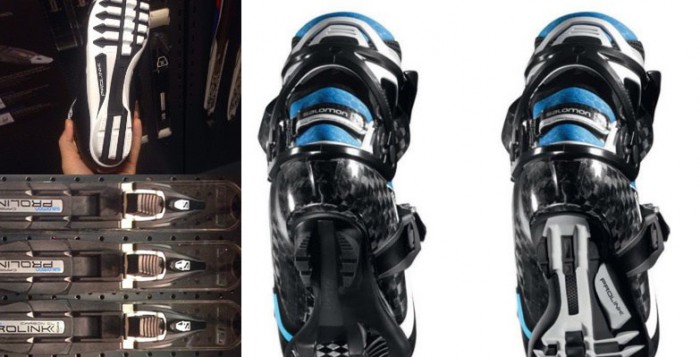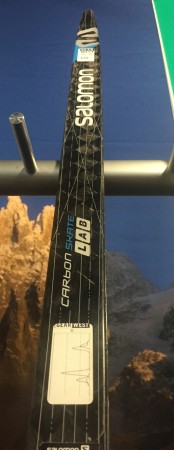
The dueling alphabet soup of binding systems is about to get a whole lot simpler. For the past decade or so it’s been two camps: Salomon’s SNS system or NNN. On Jan. 1, Salomon plans to reveal a not-so-well-kept secret.
Salomon, which is owned by the Finnish-headquartered sport conglomerate Amer Sports, will begin production of NNN-compatible boots and bindings. The new system, called Prolink, shares DNA with NNN.
According to Amer Nordic Commercial Manager Isaac Wilson, some key differences remain.
The Bindings
“Starting with the easiest and the most obvious, the binding is lighter. It’s also lower and it’s thinner,” Wilson explained on the phone.
SNS devotees often claim more sensitive ski-feel is obtained with as little material between the boot sole and the ski. (Modern NNN bindings slide onto a ski-mounted plate, called the NIS system. The binding slides onto the plate with, no drilling required, and provides some fore and aft adjustment.)
Continuing Salomon’s direct-mount legacy, Prolink bindings will screw mount directly to the ski with no NNN plate in between. To allow for an easier transition from SNS to Prolink bindings, the new system will use an identical SNS screw-hole pattern. Converting skis with SNS bindings to Prolink will be simple.

Amer Sports, which owns both Salomon and Atomic, has invested millions developing new ski technologies. Both brands helped introduce and innovate classic skis with built in skins. This year Salomon rolled out a top-end price point carbon skate and carbon classic ski.
“All of our skis, from the cheapest kids ski to the most expensive carbon ski, will all come pre-drilled based on camber of where that ski should be mounted,” Wilson said of the new easy to use mounting system. “So it makes the mounting really quick. But it’s still a direct mount to the ski so you get a really direct connection.”
Wilson asserts that differences between current NNN bindings and Prolinks don’t stop at what he claims is better snow-feel, but extend to a mechanically better connection between the boot and binding.
Salomon claims its system, which compresses against the boot’s attachment point, a thin bar near the toe, is better than the NNN closure which uses a small hooks that grip and wrap around the top of the boot bar.
“There is no compression on that system so that the bar of your boot is not actually held or pressed tightly, there is a lot more movement involved,” Wilson said.
With the tighter connection, Salomon suggests its system will last longer and provide a more seamless interface between boot and ski.
The Boots
Salomon’s plan for the immediate future is to produce two runs of identical boots in each model, one with a SNS sole, the other a Prolink sole.
“We will have starting with the S-Lab Pro all the way down to the Escape touring boot, everything in there will be offered in either option,” Wilson said. “We want the conversation to turn away from, ‘What system are you on?’ to ‘What boot fits you the best? What skis do you like the most? What are the most relevant technology for you?’ Not so much, ‘What is the system you are currently using?’ ”

In the long term, production runs of boots offering an “either or” option may not be cost effective. Salomon is already thinking ahead. It’s skyrocket price Carbon Skate Lab boot pushes beyond 1K for a pair. Yet it remains a way for Salomon designers to prototype modular boot systems.
“When you go to our Carbon boot, and our new Carbon Classic boot, they will actually come with a shell with cleats … They will come with both cleats so you will have the ability to have both in the box. You’ll be able to have an SNS cleat and a Prolink cleat [that is NNN compatible] in the system,” Wilson said. “The goal will be like a cycling shoe where you never worry about what pedal you are using.”
The Binding Wars and the Bottom Line
Binding compatibility is downright unglamorous. But as the interface between ski and boot, binding compatibility is a gateway to greater profitability. For example, with the NNN system buyers have many brands to choose from to optimize fit; there’s Rossignol, Alpina, Madshus, and Fischer — just to name the major players. If your ski race quiver includes NNN bindings, it makes the most sense to purchase boots from these brands. If Salomon or Atomic boots are the most comfortable fit, then up to now, the SNS system was mandatory.
Amer Sport’s business model worked for awhile. The SNS system held strong here in the U.S. Yet gradually, brand influencers, like coaches and their ski clubs, as well as top World Cup skiers, switched to NNN. At one ski club in Bend, Ore., you’re likely to see only a few pair of Salomon boots amidst a group of 30 to 40 skiers on any given day.
Internationally, the SNS system is quite robust.
“In Germany, it’s still 80 percent,” Wilson said. “But in the U.S. and a few other places we have four really strong competitors and we lost partnership with Fischer a few years ago. Our market share shrunk. We went from 65- to 70-percent market share in the U.S. to just about 35 percent.”
In places like Norway, a major nordic-ski product consumer, SNS became an afterthought as well. Wilson said that despite Amer Sport’s investments in high end ski production, they simply were preaching to a smaller and smaller choir.
“At the end of the day, in all the business meetings we were in, we were saying no matter how much we do this we are only speaking to 35 percent of the industry, and that we are spending an awful lot of money to talk to 35 percent of the people.”
Salomon could have moved on this earlier, he added. “My biggest thing is, OK, we could have done it ten years ago, but I’m just really happy we are doing it now. … It’s hard to admit that we need to play across the full range of systems … so that we can be back to where we once were which is a much higher market share especially in boots where we are the most relevant brand still in the industry.”
Salomon’s bottom line is likely to be bolstered by the Prolink system’s introduction. Wilson explained the system is an NNN upgrade, but it’s not revolutionary. Put simply, now Salomon can attract consumers who simply prefer their boots and don’t want to change binding systems from NNN to SNS.
“Hopefully it allows people to open the ability for them to take Salomon or Atomic product and not close the door for us,” he added.
“I am proud that Salomon was not too proud to do this … I think they were really globally not that worried about it and now I think especially if they ever want to play in the Norwegian market, if they ever want to play in the U.S. market in a real way, this was a move that they had to do. I think they came to that realization and they did it.”
Wilson admitted he’s asked the question again and again — does this mean Salomon has lost the binding battle or lost the war? “For me, it’s a funny way to think about it. I feel like hopefully the consumer is the one who wins this in the end. So nobody has lost but the consumer comes out as a winner.”
Jason Albert
Jason lives in Bend, Ore., and can often be seen chasing his two boys around town. He’s a self-proclaimed audio geek. That all started back in the early 1990s when he convinced a naive public radio editor he should report a story from Alaska’s, Ruth Gorge. Now, Jason’s common companion is his field-recording gear.



